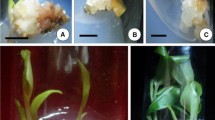Abstract
This study investigates the frequency of apparent and permanent expression of marker change following two types of tissue culture, conventional callus and direct regeneration cultures, and for two markers it relates this frequency to that following breeding. Each clone was used for only one marker. After conventional callus culture, plants of the sugarcane clone Arundoid B, a clone having a growth habit with shortened internodes and leaves, were freed of this marker at a rate of 1 in 172 plants. Marker remission in a second clone with a leaf blotch was enhanced in the presence of a mutagen. Callus culture alone gave a remission rate of 1/280 plants, while treatment of callus with ethyl methanesulfonate gave a remission rate of 1/42 plants. Of two markers subjected to vegetative and sexual transmission, the first, a leaf marker, was stable in callus culture with no remissions; crossing with non-marker parents produced progeny with 54% lacking the marker. The second, a stalk marker (multibud), showed epigenetic effects during two generations of vegetative propagation; plants lacking the multibud marker produced vegetative progeny in which the marker reappeared. Nine crosses to nonmarker parents produced progeny of which an average of 29% had the marker. The use of stalk chimeras as markers demonstrated that passage through conventional callus or direct regeneration culture resulted in the loss of the donor phenotype in all plants regenerated. Phenotypic variation in plants derived from callus culture appears to arise from several sources; chimeral segregants, epigenetic transients, and mutational variants.
Similar content being viewed by others
References
Artschwager E & Brandes EW (1958) Sugarcane (Saccharum officinarum L.), origin, classification, characteristics and descriptions of representative clones. Agriculture Handbook 122, US Dept Agric, Washington DC
Evans DA (1989) Somaclonal variation-genetic basis and breeding applications. Trends in Gen. 5: 46–50
Heinz DJ & Mee GWP (1969) Plant differentiation from callus tissue of Saccharum species. Crop. Sci. 9: 346–348.
Heinz DJ & Mee GP (1971) Morphologic, cytogenetic and enzymatic variation in Saccharum species and hybrid clones derived from tissue culture. Am.J. Bot. 58: 257–262
Heinz DJ, Krishnamurthi M, Nickell LG & Maretzki A (1977) Cell, tissue and organ culture in sugarcane improvement. In: Reinert J & Bajaj YPS (Eds) Plant Cell, Tissue and Organ Culture (pp 3–17). Springer-Verlag, Berlin
Ho WJ & Vasil IK (1983) Somatic embryogenesis in sugarcane (Saccharum officinarum) I. The morphology and physiology of callus formation and the ontogeny of somatic embryos. Protoplasma 118: 169–180
Hughes CG (1964) Genetical effects. In: Hughes CG, Abbott EV & Wismer CA (Eds) Sugar-Cane Diseases of the World. II. (pp 265–296). Elsevier, Amsterdam
Irvine JE (1984) The frequency of marker changes in sugarcane plants regenerated from callus culture. Plant Cell Tiss. Org. Cult. 3: 201–209
Irvine JE & Benda GTA (1987) Transmission of sugar cane diseases in plants derived by rapid regeneration from diseased leaf tissue. Sugar Cane 6 Nov/Dec: 14–16
Irvine JE, Fitch M & Moore PH (1983) The induction of callus in sugarcane tissue cultures by selected chemicals. Plant Cell Tiss. Org. Cult. 2: 141–149
Larkin PJ & Snowcroft WR (1981) Somaclonal variation-a novel source of variability from cell cultures for plant improvement. Theor. Appl. Gen. 60: 197–214
Liu MC & Chen WH (1976) Tissue and cell culture as aids to sugarcane breeding. 1. Creation of genetic variation through callus cultures. Euphytica 25: 393–403
Miller JD (1985) Variation in tissue-culture sub-clones of sugar cane. Sugar Cane 1 Jan/Feb: 11–15
Neilson-Jones W (1969) Plant Chimeras. 2nd ed. (pp 61–62). Methuen & Co Ltd London
Poethig S (1989) Genetic mosaic and cell lineage analysis in plants. Trends in Gen. 5: 273–277
Shepard JF, Bidney D & Shahin E (1980) Potato proto-plasts in crop improvement. Sci. 208: 17–24
Stewart RN (1978) Ontogeny of the primary body in chimeral forms of higher plants. In: Subtelny S & Sussex IM (Eds) The Clonal Basis of Development (pp 131–160). Prentice-Hall, Englewood Cliffs, NJ
Smith RH & Norris RH (1983) In vitro propagation of African violet chimeras. HorSci. 18: 436–437
Thielke C (1964) Histologische Untersuchungen am Sprosscheitel von Saccharum IV. Der Sprossscheitel von Saccharum officinarum L. Planta 62: 332–349
Varga A, Thoma LH & Bruinsma J (1988) Effects of auxins and cytokinins on epigenetic instability of calluspropagated Kalanchoe blossfeldiana Poelln. Plant Cell Tiss. Org. Cult. 15: 223–231
Vogel E & Natarajan AT (1982) The relation between reaction kinetics and mutagenic action of monofunctional alkylating agents in higher eucaryotic systems: interspecies comparisons. In: de Serres FD & Hollaender A (Eds) Chemical Mutants, Vol 7 (pp 298–312). Plenum NY
Author information
Authors and Affiliations
Rights and permissions
About this article
Cite this article
Irvine, J.E., Benda, G.T.A., Legendre, B.L. et al. The frequency of marker changes in sugarcane plants regenerated from callus culture. Plant Cell Tiss Organ Cult 26, 115–125 (1991). https://doi.org/10.1007/BF00036115
Received:
Accepted:
Issue Date:
DOI: https://doi.org/10.1007/BF00036115




